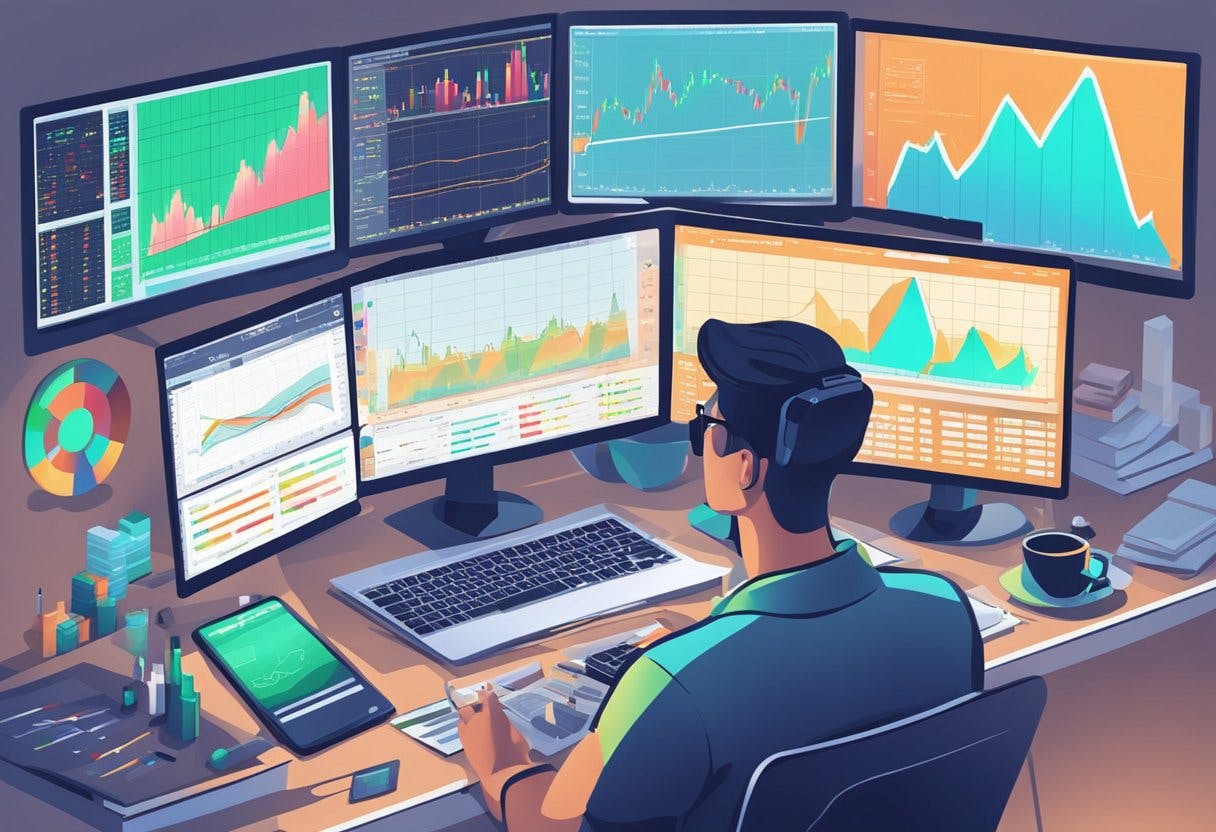
Forex trading is a popular way to make money by speculating on the movements of currency pairs. However, like all forms of trading, it involves risk. One way to manage risk is by using a risk-to-reward ratio, which compares the potential profit of a trade to the potential loss. In this article, we will explore how traders can improve their risk-to-reward ratio in forex trading.

Understanding risk and reward is crucial in forex trading. A trader needs to know how much they stand to lose and gain in any given trade. Developing a trading strategy that takes into account the risk-to-reward ratio can help traders make more informed decisions. Effective risk management techniques can also help traders improve their risk-to-reward ratio. By analyzing performance metrics and adapting to market conditions, traders can make better decisions and improve their chances of success.
Key Takeaways:
- Understanding risk and reward is crucial in forex trading.
- Developing a trading strategy that takes into account the risk-to-reward ratio can help traders make more informed decisions.
- Effective risk management techniques can also help traders improve their risk-to-reward ratio.
Understanding Risk and Reward

Defining Risk-to-Reward Ratio
In Forex trading, risk-to-reward ratio refers to the potential loss versus the potential profit of a trade. It is an important metric to consider when entering a trade as it helps traders determine the potential profitability of a trade. The ratio is calculated by dividing the potential profit of a trade by the potential loss. For instance, if a trader expects to make $100 on a trade but is willing to risk losing $50, then the risk-to-reward ratio is 2:1.
Importance of Balance
While it is important to aim for high reward-to-risk ratios, it is equally important to maintain balance between risk and reward. A high risk-to-reward ratio may seem appealing, but if the potential loss is too high, it may not be worth the risk. On the other hand, a low risk-to-reward ratio may result in small gains that do not cover the costs of the trade. Therefore, traders should aim for a balance between risk and reward that suits their trading strategy and risk tolerance.
To achieve a balanced risk-to-reward ratio, traders must have a clear understanding of the market and the potential risks and rewards associated with each trade. They must also have a well-defined trading plan that includes risk management strategies to minimize potential losses. This includes setting stop-loss orders, taking profits at predetermined levels, and avoiding emotional trading decisions.
In summary, understanding risk and reward is crucial to improving one’s risk-to-reward ratio in Forex trading. Traders must aim for a balance between risk and reward that suits their trading strategy and risk tolerance. They must also have a well-defined trading plan that includes risk management strategies to minimize potential losses.
Developing a Trading Strategy

Developing a trading strategy is an essential step for traders looking to improve their risk-to-reward ratio in forex trading. A trading strategy is a set of rules and guidelines that a trader follows to make trading decisions.
Technical vs Fundamental Analysis
When developing a trading strategy, traders must decide whether to use technical analysis, fundamental analysis, or a combination of both. Technical analysis involves the study of charts and past market data to identify patterns and trends. Fundamental analysis, on the other hand, involves analyzing economic and financial data to identify the underlying factors that drive market movements.
Traders must choose the approach that aligns with their trading style and risk tolerance. Technical analysis is more suitable for short-term traders who rely on price movements to make trading decisions. Fundamental analysis is more appropriate for long-term traders who focus on the underlying economic and financial factors that drive market movements.
Setting Realistic Profit Targets
Setting realistic profit targets is another crucial step in developing a trading strategy. Traders must set profit targets that are achievable based on their trading approach and market conditions. Unrealistic profit targets can lead to overtrading, which can increase the risk of losses.
Traders must also consider their risk-to-reward ratio when setting profit targets. A risk-to-reward ratio of 1:2 or higher is considered ideal. This means that for every dollar risked, the trader aims to make a profit of at least two dollars.
Incorporating Support and Resistance Levels
Incorporating support and resistance levels in a trading strategy can also help improve the risk-to-reward ratio. Support and resistance levels are areas on a chart where the price has historically reversed or stalled.
Traders can use these levels to identify potential entry and exit points. By entering trades at support levels and exiting at resistance levels, traders can increase their chances of making profitable trades while minimizing their risk.
In conclusion, developing a trading strategy is crucial for traders looking to improve their risk-to-reward ratio in forex trading. Traders must choose the approach that aligns with their trading style, set realistic profit targets, and incorporate support and resistance levels in their strategy. By following these guidelines, traders can increase their chances of making profitable trades while minimizing their risk.
Effective Risk Management
Effective risk management is essential for improving risk-to-reward ratio in Forex trading. In this section, we will discuss some of the key elements of effective risk management that traders can use to improve their risk-to-reward ratio.
Position Sizing
Position sizing is a critical component of effective risk management. It refers to the size of the position a trader takes in a particular trade. By managing position sizing, traders can better control their exposure to risk and avoid over-leveraging their capital. One popular approach to position sizing is the “2% rule,” which suggests that traders should never risk more than 2% of their capital on a single trade.
Using Stop Loss and Take Profit Orders
Stop loss and take profit orders are essential tools for managing risk in Forex trading. A stop loss order is an instruction to close a trade at a predetermined price level to limit losses if the market moves against the trader. A take profit order is an instruction to close a trade at a predetermined price level to lock in profits if the market moves in the trader’s favor. By using stop loss and take profit orders, traders can manage their risk and protect their capital.
Understanding Leverage and Its Risks
Leverage is a powerful tool that can amplify profits in Forex trading. However, it also comes with significant risks. Traders who use leverage must be aware of the potential for losses and manage their risk accordingly. One way to manage risk when using leverage is to reduce position size or use tighter stop loss orders.
Overall, effective risk management is critical for improving risk-to-reward ratio in Forex trading. Traders who use position sizing, stop loss and take profit orders, and understand the risks of leverage can better manage their risk and increase their chances of success.
Analyzing Performance Metrics
To improve the risk-to-reward ratio in forex trading, analyzing performance metrics is crucial. These metrics can help traders identify their strengths and weaknesses, which can help them make more informed trading decisions. Here are two important metrics to consider:
Win Rate and Success Rate
Win rate and success rate are two different metrics that traders should analyze. Win rate is the percentage of winning trades out of all trades taken, while success rate is the percentage of profitable trades out of all trades taken.
A high win rate does not necessarily mean a trader is profitable. For example, if a trader has a win rate of 80%, but their average winning trade is only half the size of their average losing trade, they may not be profitable overall. On the other hand, a trader with a lower win rate but higher success rate may be more profitable if their winning trades are significantly larger than their losing trades.
Expectancy and Positive Expectancy
Expectancy is a metric that takes into account both win rate and the average win/loss ratio. It calculates the average profit or loss per trade, factoring in the probability of winning or losing. A positive expectancy means that a trader can expect to make money over the long run.
Positive expectancy is achieved when the average winning trade is larger than the average losing trade. For example, if a trader has a win rate of 50% and their average winning trade is $200 while their average losing trade is $100, their expectancy would be $50 per trade. A positive expectancy of even a small amount can lead to significant profits over time.
By analyzing these performance metrics, traders can gain a better understanding of their trading performance and make more informed decisions to improve their risk-to-reward ratio.
Adapting to Market Conditions
Adapting to market conditions is a key factor in improving the risk-to-reward ratio in Forex trading. As market conditions change, traders need to adjust their strategies to remain profitable. Two important considerations when adapting to market conditions are volatility and time frame.
Volatility and Time Frame Considerations
Volatility is a measure of the price movement of a currency pair over a specific period. It is important to consider volatility when selecting a time frame for trading. High volatility can provide opportunities for large profits but also carries higher risk. Low volatility can make it difficult to find profitable trades but also carries lower risk.
Traders should consider their risk tolerance and trading style when selecting a time frame. For example, a scalper may prefer to trade on a shorter time frame with high volatility, while a day trader may prefer a longer time frame with lower volatility.
Adjusting Strategies for Different Currency Pairs
Different currency pairs may require different strategies due to their unique characteristics. For example, the EUR/USD is a popular currency pair that is known for its liquidity and low spreads. Traders may need to adjust their risk-to-reward ratio when trading this pair due to its low volatility.
Traders should also consider the trade setup when adjusting their risk-to-reward ratio. A trade setup that has a high probability of success may require a lower risk-to-reward ratio to remain profitable. Conversely, a trade setup that has a lower probability of success may require a higher risk-to-reward ratio to remain profitable.
In conclusion, adapting to market conditions is essential for improving the risk-to-reward ratio in Forex trading. Traders should consider volatility and time frame when selecting a trading strategy and adjust their risk-to-reward ratio based on the currency pair and trade setup.
Frequently Asked Questions
What strategies can be employed to enhance the risk-to-reward ratio in swing trading?
Swing traders can employ several strategies to enhance their risk-to-reward ratio. One such strategy is to set realistic stop-loss and take-profit levels based on technical analysis and market conditions. Another strategy is to use trailing stop-loss orders to lock in profits as the trade moves in the trader’s favor. Additionally, swing traders can use a combination of technical indicators and chart patterns to identify high-probability trades with favorable risk-to-reward ratios.
How do you calculate and interpret the risk-to-reward ratio using TradingView tools?
TradingView is a popular charting platform that provides traders with a variety of tools to calculate and interpret the risk-to-reward ratio. To calculate the risk-to-reward ratio using TradingView, traders can use the platform’s built-in risk-to-reward ratio calculator. To interpret the risk-to-reward ratio, traders should aim for a ratio of at least 2:1, meaning that the potential profit on a trade should be at least twice the potential loss.
What methods can traders use to effectively utilize a risk-to-reward ratio chart?
Traders can use a risk-to-reward ratio chart to identify high-probability trades with favorable risk-to-reward ratios. To effectively utilize a risk-to-reward ratio chart, traders should aim to identify trades with a ratio of at least 2:1, meaning that the potential profit on a trade should be at least twice the potential loss. Additionally, traders should use technical analysis and chart patterns to identify high-probability trades with favorable risk-to-reward ratios.
What are the implications of using a 3 to 1 risk-to-reward ratio in trading decisions?
Using a 3 to 1 risk-to-reward ratio in trading decisions can have several implications for traders. One implication is that traders may be able to achieve higher profits on winning trades while minimizing losses on losing trades. Additionally, using a 3 to 1 risk-to-reward ratio can help traders maintain a favorable risk-to-reward ratio over the long term, which can lead to more consistent profits.
In what ways can a trader adjust their approach to achieve a 2 to 1 risk-to-reward ratio?
Traders can adjust their approach to achieve a 2 to 1 risk-to-reward ratio by setting realistic stop-loss and take-profit levels based on technical analysis and market conditions. Additionally, traders can use trailing stop-loss orders to lock in profits as the trade moves in their favor. Finally, traders can use a combination of technical indicators and chart patterns to identify high-probability trades with favorable risk-to-reward ratios.
What steps can be taken to minimize forex trading risks while maximizing potential rewards?
To minimize forex trading risks while maximizing potential rewards, traders should use a combination of technical analysis and fundamental analysis to identify high-probability trades with favorable risk-to-reward ratios. Additionally, traders should set realistic stop-loss and take-profit levels based on technical analysis and market conditions. Finally, traders should use proper risk management techniques, such as position sizing and diversification, to minimize the impact of losses on their overall trading portfolio.
Read More




